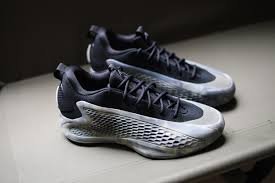My Experience with Full-Length Carbon Fibre Basketball Shoes and Lower Extremity Muscle Strain – A Podiatrist’s Perspective
As a podiatrist and an avid basketball enthusiast, I’m always interested in testing innovations in athletic footwear. Recently, I trialled a pair of full-length carbon fibre basketball shoes (Adidas AE1 + Li Ning Way of Wade Fission 9) that promised increased energy return, responsiveness, and court performance. While the initial feel was impressive, I soon developed symptoms of muscle strain in my lower limbs. This experience prompted a deeper reflection on how footwear technology interacts with the biomechanics of the lower extremity.
Adidas AE1
Way of Wade Fission 9
What are Carbon Fibre Basketball Shoes?
Carbon fibre plates are embedded into the midsole of certain athletic shoes to enhance stiffness, propulsion, and energy return, particularly during high-impact movements like sprinting and jumping. Originally popularised in distance running shoes (e.g., Nike Vaporfly), this technology has now found its way into basketball footwear, where quick changes in direction, deceleration, and vertical leap are key performance features.
My Experience: Immediate Responsiveness, Gradual Strain
Upon wearing the shoes during indoor court sessions, I immediately noticed improved spring during toe-off phases, especially during sprints and rebounds. However, within a few days of use, I began experiencing:
Tightness and fatigue in my posterior chain, particularly the gastrocnemius-soleus complex (Calf muscle region)
As a podiatrist, I recognised that this discomfort likely stemmed from altered force distribution and muscle recruitment patterns due to increased sole rigidity.
Understanding the Cause: Altered Muscle Loading
Research has shown that carbon fibre plates can alter joint kinetics and redistribute mechanical demands across the lower limb (Mcleod et al., 2020). This increased stiffness in the midsole can reduce ankle dorsiflexion, leading to compensatory overuse of the proximal muscles (e.g., calves, hamstrings) during explosive movements (Healey & Hoogkamer, 2021). Additionally, the energy return provided by the carbon plate may reduce natural foot motion, resulting in muscle groups having to adapt to an altered loading pattern.
For basketball athletes, who rely heavily on agility and multidirectional stability, this altered mechanics may predispose to strain-type injuries, especially if the neuromuscular system has not had time to adapt.
Lessons Learned and Clinical Recommendations
Gradual Adaptation Is Key: Introducing carbon fibre footwear should be done progressively. Abrupt transitions may overwhelm muscle groups unaccustomed to altered kinetics.
Strength and Conditioning: Adequate posterior chain strengthening and proprioceptive training should be emphasised before incorporating performance-enhancing footwear. - in other words; Before using shoes designed to boost performance (like carbon fibre running shoes), it's important to first build up strength in the muscles along the back of your body—such as your glutes, hamstrings, and calves. You should also work on improving your balance and body awareness (proprioception) to help prevent injuries and improve movement control.
Footwear Individualisation: Not all athletes benefit equally from carbon plates. Foot type, biomechanics, and training intensity should guide shoe selection.
Clinical Vigilance: If patients or athletes present with sudden lower extremity muscle tightness or strain post footwear change, consider footwear as a contributing factor.
Conclusion
While full-length carbon fibre basketball shoes offer tangible performance benefits, they may also pose a risk of lower limb overuse if not properly introduced. My personal experience reaffirms the need for caution, education, and personalised clinical advice when trialling performance-enhancing footwear.
References
Healey, L. A., & Hoogkamer, W. (2021). Longitudinal bending stiffness does not affect running economy in Nike Vaporfly shoes. Footwear Science, 13(1), 13–20. https://doi.org/10.1080/19424280.2020.1828616
Mcleod, R. R., Bruening, D. A., & Farris, D. J. (2020). The role of the longitudinal arch in explosive athletic movements. Journal of Biomechanics, 105, 109768. https://doi.org/10.1016/j.jbiomech.2020.109768

